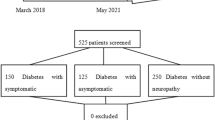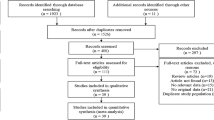Abstract
Previous studies suggested a possible association between serum uric acid levels and peripheral neuropathy in patients with type 2 diabetes, but no definite evidence was available. A systematic review and meta-analysis of relevant studies were performed to comprehensively estimate the association. Pubmed, Web of Science, Embase, and China Biology Medicine (CBM) databases were searched for eligible studies. Study-specific data were combined using random-effect or fixed-effect models of meta-analysis according to between-study heterogeneity. Twelve studies were finally included into the meta-analysis, which involved a total of 1388 type 2 diabetic patients with peripheral neuropathy and 4746 patients without peripheral neuropathy. Meta-analysis showed that there were obvious increased serum uric acid levels in diabetic patients with peripheral neuropathy (weighted mean difference [WMD] = 50.03 μmol/L, 95 % confidence interval [95%CI] 22.14–77.93, P = 0.0004). Hyperuricemia was also significantly associated with increased risk of peripheral neuropathy in patients with type 2 diabetes (risk ratio [RR] = 2.83, 95%CI 2.13–3.76, P < 0.00001). Meta-analysis of two studies with adjusted risk estimates showed that hyperuricemia was independently associated with increased risk of peripheral neuropathy in type 2 diabetic patients (RR = 1.95, 95%CI 1.23–3.11, P = 0.005). Type 2 diabetic patients with peripheral neuropathy have obvious increased serum uric acid levels, and hyperuricemia is associated with increased risk of peripheral neuropathy. Further prospective cohort studies are needed to validate the impact of serum uric acid levels on peripheral neuropathy risk.




Similar content being viewed by others
References
Callaghan BC, Cheng HT, Stables CL, Smith AL, Feldman EL (2012) Diabetic neuropathy: clinical manifestations and current treatments. Lancet Neurol 11(6):521–534
Tesfaye S, Selvarajah D (2012) Advances in the epidemiology, pathogenesis and management of diabetic peripheral neuropathy. Diabetes Metab Res Rev 28 Suppl :18–14
Smith SC, Lamping DL, Maclaine GD (2012) Measuring health-related quality of life in diabetic peripheral neuropathy: a systematic review. Diabetes Res Clin Pract 96(3):261–270
Monteiro-Soares M, Vaz-Carneiro A, Sampaio S, Dinis-Ribeiro M (2012) Validation and comparison of currently available stratification systems for patients with diabetes by risk of foot ulcer development. Eur J Endocrinol 167(3):401–407
Xu Y, Zhu J, Gao L, Liu Y, Shen J, Shen C, Matfin G, Wu X (2013) Hyperuricemia as an independent predictor of vascular complications and mortality in type 2 diabetes patients: a meta-analysis. PLoS One 8(10):e78206
Han T, Bai J, Liu W, Hu Y (2012) A systematic review and meta-analysis of alpha-lipoic acid in the treatment of diabetic peripheral neuropathy. Eur J Endocrinol 167(4):465–471
Gonzalez R, Pedro T, Martinez-Hervas S, Civera M, Priego MA, Catala M, Chaves FJ, Ascaso JF, Carmena R, Real JT (2012) Plasma homocysteine levels are independently associated with the severity of peripheral polyneuropathy in type 2 diabetic subjects. J Peripher Nerv Syst 17(2):191–196
Abbott CA, Malik RA, van Ross ER, Kulkarni J, Boulton AJ (2011) Prevalence and characteristics of painful diabetic neuropathy in a large community-based diabetic population in the U.K. Diabetes Care 34(10):2220–2224
Martinon F (2010) Mechanisms of uric acid crystal-mediated autoinflammation. Immunol Rev 233(1):218–232
Li C, Hsieh MC, Chang SJ (2013) Metabolic syndrome, diabetes, and hyperuricemia. Curr Opin Rheumatol 25(2):210–216
Johnson RJ, Nakagawa T, Sanchez-Lozada LG, Shafiu M, Sundaram S, Le M, Ishimoto T, Sautin YY, Lanaspa MA (2013) Sugar, uric acid, and the etiology of diabetes and obesity. Diabetes 62(10):3307–3315
Hoeldtke RD, Bryner KD, McNeill DR, Hobbs GR, Riggs JE, Warehime SS, Christie I, Ganser G, Van Dyke K (2002) Nitrosative stress, uric acid, and peripheral nerve function in early type 1 diabetes. Diabetes 51(9):2817–2825
Kim SY, Guevara JP, Kim KM, Choi HK, Heitjan DF, Albert DA (2010) Hyperuricemia and coronary heart disease: a systematic review and meta-analysis. Arthritis Care Res (Hoboken) 62(2):170–180
Chuengsamarn S, Rattanamongkolgul S, Jirawatnotai S (2014) Association between serum uric acid level and microalbuminuria to chronic vascular complications in Thai patients with type 2 diabetes. J Diabetes Complicat 28(2):124–129
Kiani J, Habibi Z, Tajziehchi A, Moghimbeigi A, Dehghan A, Azizkhani H (2014) Association between serum uric acid level and diabetic peripheral neuropathy (a case control study). Caspian J Intern Med 5(1):17–21
Papanas N, Katsiki N, Papatheodorou K, Demetriou M, Papazoglou D, Gioka T, Maltezos E (2011) Peripheral neuropathy is associated with increased serum levels of uric acid in type 2 diabetes mellitus. Angiology 62(4):291–295
Lu B, Hu J, Wen J, Zhang Z, Zhou L, Li Y, Hu R (2013) Determination of peripheral neuropathy prevalence and associated factors in Chinese subjects with diabetes and pre-diabetes—ShangHai Diabetic neuRopathy Epidemiology and Molecular Genetics Study (SH-DREAMS). PLoS One 8(4):e61053
Tapp RJ, Shaw JE, de Courten MP, Dunstan DW, Welborn TA, Zimmet PZ (2003) Foot complications in type 2 diabetes: an Australian population-based study. Diabet Med 20(2):105–113
Wells G, Shea B, O’connell D, Peterson J, Welch V, Losos M, Tugwell P (2014) The Newcastle-Ottawa Scale (NOS) for assessing the quality of nonrandomised studies in meta-analyses. Ottawa Health Research Institute Web site
Cochran WG (1954) The combination of estimates from different experiments. Biometrics 10(1):101–129
Higgins JP, Thompson SG, Deeks JJ, Altman DG (2003) Measuring inconsistency in meta-analyses. BMJ 327(7414):557–560
DerSimonian R, Laird N (1986) Meta-analysis in clinical trials. Control Clin Trials 7(3):177–188
Mantel N, Haenszel W (1959) Statistical aspects of the analysis of data from retrospective studies of disease. J Natl Cancer Inst 22(4):719–748
Egger M, Davey Smith G, Schneider M, Minder C (1997) Bias in meta-analysis detected by a simple, graphical test. BMJ 315(7109):629–634
Pinto A, Tuttolomondo A, Di Raimondo D, Fernandez P, La Placa S, Di Gati M, Licata G (2008) Cardiovascular risk profile and morbidity in subjects affected by type 2 diabetes mellitus with and without diabetic foot. Metabolism 57(5):676–682
Ito H, Abe M, Mifune M, Oshikiri K, Antoku S, Takeuchi Y, Togane M (2011) Hyperuricemia is independently associated with coronary heart disease and renal dysfunction in patients with type 2 diabetes mellitus. PLoS One 6(11):e27817
Meng L, Zhu J (2008) An analysis of clinical features of accompanying periphery neuropathy in 132 cases with type 2 diabetes [article in Chinese]. J Xinjiang Med Univ 31(5):515–520
Guo L, Luo Y, Liu W, Luan J, Yang H, Chen B (2012) Level of UA and related factors in DPN patients [article in Chinese]. Anhui Med Pharma J 16(1):73–75
Sang Y (2012) Relationship between serum uric acid and microvascular complications in patients with type 2 diabetes mellitus [article in Chinese]. J Med Forum 33(8):25–26
Wang S (2012) Correlation analysis between the hyperuricemia and diabetic peripheral neuropathy [article in Chinese]. China Med Pharm 2(5):169–170
Wei X, Wu W (2012) The correlation analysis of hyperuricemia and vascular complications of type II diabetes [article in Chinese]. Med J West China 24(5):891–895
Xin S, Zhang L (2012) Correlation ship of serum uric acid with type 2 diabetic peripheral neuropathy [article in Chinese]. Clin Med 32(9):26–27
Gong L, Huang Y, Feng F (2013) Analysis of the risk factors in type 2 diabetics with hyperuricaemia [article in Chinese]. Acta Acad Med Wannan 32(4):304–306
Premkumar LS, Pabbidi RM (2013) Diabetic peripheral neuropathy: role of reactive oxygen and nitrogen species. Cell Biochem Biophys 67(2):373–383
Kim SY, Guevara JP, Kim KM, Choi HK, Heitjan DF, Albert DA (2009) Hyperuricemia and risk of stroke: a systematic review and meta-analysis. Arthritis Rheum 61(7):885–892
Petta S, Camma C, Cabibi D, Di Marco V, Craxi A (2011) Hyperuricemia is associated with histological liver damage in patients with non-alcoholic fatty liver disease. Aliment Pharmacol Ther 34(7):757–766
Yang T, Chu CH, Bai CH, You SL, Chou YC, Chou WY, Chien KL, Hwang LC, Su TC, Tseng CH, Sun CA (2012) Uric acid level as a risk marker for metabolic syndrome: a Chinese cohort study. Atherosclerosis 220(2):525–531
Goncalves JP, Oliveira A, Severo M, Santos AC, Lopes C (2012) Cross-sectional and longitudinal associations between serum uric acid and metabolic syndrome. Endocrine 41(3):450–457
Choi YJ, Yoon Y, Lee KY, Hien TT, Kang KW, Kim KC, Lee J, Lee MY, Lee SM, Kang DH, Lee BH (2014) Uric acid induces endothelial dysfunction by vascular insulin resistance associated with the impairment of nitric oxide synthesis. FASEB J 28(7):3197–3204
Nagahama K, Inoue T, Iseki K, Touma T, Kinjo K, Ohya Y, Takishita S (2004) Hyperuricemia as a predictor of hypertension in a screened cohort in Okinawa, Japan. Hypertens Res 27(11):835–841
Krishnan E, Akhras KS, Sharma H, Marynchenko M, Wu EQ, Tawk R, Liu J, Shi L (2013) Relative and attributable diabetes risk associated with hyperuricemia in US veterans with gout. QJM 106(8):721–729
Papanas N, Demetriou M, Katsiki N, Papatheodorou K, Papazoglou D, Gioka T, Kotsiou S, Maltezos E, Mikhailidis DP (2011) Increased serum levels of uric acid are associated with sudomotor dysfunction in subjects with type 2 diabetes mellitus. Exp Diabetes Res 1–5
Fabbrini E, Serafini M, Colic Baric I, Hazen SL, Klein S (2014) Effect of plasma uric acid on antioxidant capacity, oxidative stress, and insulin sensitivity in obese subjects. Diabetes 63(3):976–981
Stamp LK, Turner R, Khalilova IS, Zhang M, Drake J, Forbes LV, Kettle AJ (2014) Myeloperoxidase and oxidation of uric acid in gout: implications for the clinical consequences of hyperuricaemia. Rheumatology (Oxford)
Johnson RJ, Kang DH, Feig D, Kivlighn S, Kanellis J, Watanabe S, Tuttle KR, Rodriguez-Iturbe B, Herrera-Acosta J, Mazzali M (2003) Is there a pathogenetic role for uric acid in hypertension and cardiovascular and renal diaease? Hypertension 41(6):1183–1190
Papezikova I, Pekarova M, Kolarova H, Klinke A, Lau D, Baldus S, Lojek A, Kubala L (2013) Uric acid modulates vascular endothelial function through the down regulation of nitric oxide production. Free Radic Res 47(2):82–88
Conflict of Interest
We declare that we have no conflicts of interest.
Role of the Funding Source
There was no funding source for this study.
Author information
Authors and Affiliations
Corresponding authors
Additional information
Shuai Yu, Ying Chen, and Xu Hou contributed equally to the study.
Rights and permissions
About this article
Cite this article
Yu, S., Chen, Y., Hou, X. et al. Serum Uric Acid Levels and Diabetic Peripheral Neuropathy in Type 2 Diabetes: a Systematic Review and Meta-analysis. Mol Neurobiol 53, 1045–1051 (2016). https://doi.org/10.1007/s12035-014-9075-0
Received:
Accepted:
Published:
Issue Date:
DOI: https://doi.org/10.1007/s12035-014-9075-0




